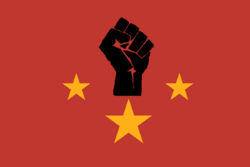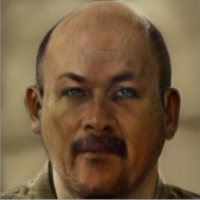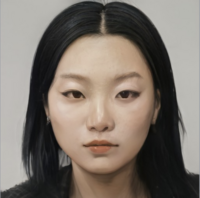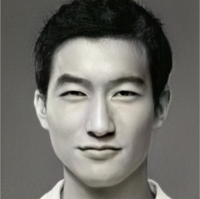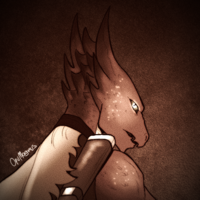United Kingdoms of Sia
United Kingdoms of Sia 新航聯合王國 | |
|---|---|
|
Flag | |
Motto: "願達引導我們的靈魂" (Sianese) "May Da guide our souls" | |
Anthem: "每個人都喜歡功夫格鬥" (Sianese) Royal anthem: "榮耀歸於大,榮耀歸於沙基拉" (Sianese) | |
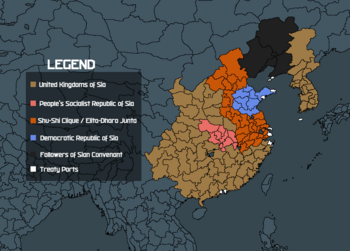 | |
| Location | Within the Eastern Asian Sphere |
| Capital and largest city | JinBei |
| Official languages | Sianese, Mongolian, CESM, Dutch. |
| Recognised national languages | Sianese |
| Recognised regional languages | Sianese |
| Ethnic groups (1950) |
|
| Religion (100 CE ~) | Great Dragons of Da |
| Demonym(s) | Sian |
| Government | Absolute Theocracy Monarchy |
• Great Emperor | Zhing Pong Dat-Dat |
• Empress | Zhao Ping Dat-Dat |
• Grand Marshal | Dai Xing |
• Senior Commander | Fu Qiqiang |
| United Kingdoms of the Sian regions a collective of petty kingdoms | |
• The unification of Sia and the revolt against the Mongolian occupation | 1100s CE |
• The Great Anarchy - Sian-Mongolian War | 1805-1807 CE |
• The Great Sianese War - a war against Western Expansion | 1910-1914 CE |
• The Sian Civil War | 1936-1938 CE |
| Population | |
• 1950 estimate | 550,000,000 - 600,000,000~ |
| Currency | Dari (SID) |
| Time zone | SEST |
| Driving side | left |
The United Kingdoms of Sia (UKS) is a collective of petty kingdoms across Sia [China]. The whole of Sia [China] is ruled over by a Great Emperor or Empress, who oversees the petty kingdoms. The petty kings and queens act as governors for their state, but the Great Emperor or Empress has full control over the entirety of the nation. The UKS form in the early 1100s CE, under the first emperorship of Aabavaanan Vaageesh the Wise, who went under his way to unite the people of Sia [China] under one banner.
History
Brief History of Sia
The lands of Sia were divided into smaller petty kingdoms, with the people divided and constantly at war with each other. It wasn’t until the Mongolian invasion into Sia, did the people of Sia decide to unite against the Mongolians after centuries of being occupied by them. Aabavaanan Vaageesh was a noble, a part of the Petty Kingdom of Vaageesh. Their origins came from the heartlands of [India], before their noble house settled into Sia and formed the Petty Kingdom of Vaageesh. It wasn’t until around the 1100s CE, did Aabavaanan Vaageesh decide to rally the Sian people under one banner and revolt against the Mongolians.
The United Kingdoms of Sia held great influence across the regions of Sia [China], and established large trade spheres across Asia and other regions beyond the vast seas. This became crucial when Sia became fairly isolated during certain periods of time. Its most notable trade routes were via the city states in the Commonwealth of Eastern Maritime States, though way before its founding to become what it is in modern times.
In 1549 CE, a conflict arose within one of the petty kingdoms of Sia. The Petty King Aiguo Chen took arms against the ruling leader of the UKS, because one - they were female. Secondly - they kept spending all the collected taxes on vanity, trinkets and curios. Thirdly and finally - they thought believing in the ‘Great Dragons’ to be absurd and disgusting.
A war broke out throughout the regions of Sia, between the Petty King and the Great Empress. Aiguo Chen managed to win the war after 20 years of brutal fighting. The victory was costly, but many of the petty kingdoms supported Aiguo Chen usurping of the Emperorship in the UKS. With the war ending in 1569 CE, a new era arose and Aiguo Chen ruled over the UKS for another 10 years, before passing at the rightful age of 71. His sons continued the Chen Dynasty for many centuries, up until the 1800s CE.
The Petty Kingdom of Dat-Dat started to undermine the Chen Dynasty, by performing covert operations and trying to weaken their influence across the UKS. The Petty King and head of the Dat-Dat bloodline, believed to be the rightful emperor of the UKS. As well made claims that he is the reincarnate of the Divine One, a mystical draconic being, that has been said to walk amongst the mortals to spread the wise words of the Great Dragons of Da. 1845 CE would be the breaking point between the Petty Kingdom of Dat-Dat and the Chen Dynasty. A holy war was declared by the Petty King of Dat-Dat, and gathered thousands of loyalists to overthrow the Emperor.
The war lasted for numerous years and ended in 1877 CE, after the Chen Emperor was killed under mysterious circumstances. With members of the Chen Dynasty refusing to give up the emperorship, they would soon meet their demise and be executed once they were captured. The Dat-Dat Dynasty soon formed and the ruling Emperor would be given the title as Holy Emperor of the UKS.
In 1909 CE, the UKS trade sphere started to wane and many nations within Asia started to turn away from the UKS. With the fear that many of the Asian nations have taken influences from the Western world,the current ruling Emperor decided to take actions into his own hands. He rallied a large military force to stop the spread of western influence. The war started in 1910 - 1914 CE, ending in a great defeat for the UKS and causing further economic issues to arise from it.
The war took a heavy toll on the populace and caused many people to turn their views away from the monarchy. Many petty kingdoms collapsed and anti-monarchist movements began to spark across the UKS. This period would lead the UKS into a great depression, lasting from the 1915s CE up until the early 1930s CE. The UKS splitted into numerous factions, each taking a holding within the UKS lands. However, up until the 1940s CE, the Great Emperor of the UKS reached out to the Mongolian people. Despite their differences and setbacks, they formed an anti-western alliance to combat the ever expanding influence of western culture within Asia.
The Great Anarchy - Sian-Mongolian War
In the 1800s, the divide in the Mongolian nation not only caused issues internally for them, but also spreaded over to the border regions of Sia. The Chen Dynasty at the time was losing its influence over Sia, as numerous internal affairs caused problems for the Great Emperor. In 1805, the United Kingdoms of Sia decided to take advantage of the shattered Mongolian empire, they believed they had the greater advantage in securing Mongolian lands under Sian authority.
The Royal Sian Army mobilized towards the Sian-Mongolian border, before preparing for the great offensive into Mongolia. However, underestimating the Mongolian people, they faced sheer resistance from armed militia and a unified Mongolian force. Tuvan Khanate managed to withstand the Sian onslaught, and proved to be a tough foe for the UKS. The conflict lasted for 2 years, ending in 1807 with the Royal Sian Army withdrawing its forces in the southernmost regions of Mongolia. This military embarrassment only led the Chen Dynasty to decline further, and allowed for the Petty Kingdom of Dat-Dat to instate its influence across Sia.
The Great Sianese War
The Great Sianese War started in 1910, with the Dat-Dat Dynasty declaring a holy war against Western influence in Asia. Calling upon those wishing to stand up against Western expansion, the Great Emperor Peng Dat-Dat managed to rally a sizable army to seize all of Western Asia under the UKS. The Royal Sian Army managed to push its forces deep into Asia, securing smaller provinces and city states under the UKS. The first year of the war proved to fall into the UKS’s favor, before starting to go south during the second year of the war.
Numerous nations from the West partook in the conflict to quell the conflict, proving to be a difficult foe for the UKS. The Royal Sian Army suffered moderate losses throughout each engagement, due to the lack of proper communications and organization. The entire Sian campaign would come to a messy end, with many Sian soldiers giving up or refusing to fight a futile war. The war ended in 1914, with the Great Emperor Peng signing a treaty with the Western nations involved in the war.
A year later, numerous factions splitted off from the UKS, as the UKS started to become fairly unstable and on the brink of collapse. With growing tension sparking between all factions, it would be matters of years before another war would break out.
The Sian Civil War
The Sian Civil War kicked off in 1936, when the Great Emperor decided to reintegrate it’s lost territory back into the UKS. Better prepared and organized, the Royal Sian Army performed much better in dealing with the factions. The civil war only lasted up until the end of 1938. An agreement was made between all parties, at the cost of the factions independence. Each faction is made to pay tribute to the UKS, and must abide by UKS authority.
Factions of Sia
| Flag | Faction's Name | Background | Ideology Type |
|---|---|---|---|
| People's Socialist Republic of Sia |
PSRS formed during the end of the Sianese Great War against the West. Its ideals take great influence from [Russian] politics and other western ideals elsewhere. However, greatly isolated from the rest of the world, the PSRS are fairly weak and form an almost communist-monarchist government, to appease the UKS. While many greatly despise the UKS, they do not have the manpower or the resources to spread their influence across Sia [China], not without taking great losses for little gain. |
Communist-Monarchist | |
| Shi-Shu Clique / Elito-Dharo Junta | A Nationlistic and Militaristic group that consists of a [Dutch-Chinese] populace and heavy western influence. Seeing the military weakness in the UKS, they strive to perfect that flaw and rid anything that shows the weakness within the military might of the Sian people. They did make an attempt to overthrow the emperor of the UKS, but failed greatly with the lack of support of Western backers. The SSC and other factions formed an agreement with the UKS and joined back into the UKS, while being made to pay regular tribute to the current Emperor.
The SSC despises the UKS and its anti-western views. Seeing the UKS ignorance of the West as a weakness, they hope to one day be able to exploit its weakness and bring an end to the monarchy. However, they do hold rivalry with the PSRS and the Sian Democratic Republic. |
Socialist Nationalist-Militarist | |
| Sian Democratic Republic | SDR is another faction heavily influenced by the west. Considered to be the most westernized part of the whole of China, they are fairly independent from the UKS. They despise the UKS for being anti-western and being ignorant of changing times. With the UKS war on the West failing miserably, a warlord would lead the SDR into being an independent nation. Though, after many decades since the Great Sianese War, the UKS would learn from its past failure and attempt to wrangle all the factions back into the UKS.
While the SDR did fend off the UKS invasion for a time, they couldn’t sustain long enough to withstand the onslaught from UKS military forces. With the West unable to back them fully, they were forced to sign a treaty like many of the other factions did. A puppet under the UKS, they await for a time to break free from the monarchy and spread democracy and liberty across the Asian region. |
Democratic Republic Neoliberals | |
| Followers of Sian Covenant | A radicalized group of Ashtonites, who derived from Vesperia . They take a rather zealous approach to the teachings, while adding their own beliefs to fit their agendas. Many Ashtonites who may encounter these followers, may see them gone astray from the core tenets. The FSC spread fairly quickly during the end of the Great Sianese War, as many believers of the UKS religion lost faith with the great defeat of the monarchy.
Many FSC members are heavily influenced by the Western world and often bring a lot of western trinkets and curios with them. They do not wish to bring any harm to the UKS, but wish to prosthelytize to the Sian people and convert them to their faith. |
Religious Zealots |
Important Figures
| Figure's Names | Background | |
|---|---|---|
| Grand Marshal Dai Xing | Born in October 1889, Dai Xing grew up in the poorer regions of the United Kingdoms of Sia. His parents were both rice farmers and worked non-stop to make a living. When Dai became of age, he decided to enlist into the army to experience a life away from the mundane rice fields. He served as an infantryman and would partake in the Great Sianese War.
The Great Sian War took a heavy toll on Dai psyche, as the war was fought poorly by the soldiers of the UKS. With the chain of command not prepared to face the superiority of the Western forces, the Royal Sian Army suffered horrific losses. The whole war ended after 4 years of brutal bloodshed. Dai decided to work hard to rise through the ranks of the Royal Sian Army , wishing to prove his capable leadership. Gaining a better understanding of how the Westerners fought during the Great Sian War in 1910, Dai knowledge would later prove crucial in the Sian Civil War. | |
| Senior Commander Fu Qiqiang | Born in March 1895, Fu Qiqiang grew up in the developed parts of Sia. Borned in one of the major cities in the United Kingdoms of Sia, his family had a great reputation with some of the Petty Kings and Queens of the region. Fu ended up joining the Royal Military Academy when he became of age and started off as a minor officer of the Royal Sian Army.
Fu never partook in the Great Sianese War, but knew of some of his family members that did when he was younger. Fu grew curious to what brought the horrific defeat of the Royal Sian Army, thus he took it upon himself to study a way to not fall into the same mistakes. | |
| Princess Luo Dat-Dat | Born in September 1925, Luo Dat-Dat is the daughter of Zhong Ping Dat-Dat and the eldest of the 5 other siblings she has. She grew up in the capital of the United Kingdoms of Sia, the city known as Jinbei [Beijin]. She was generally kept out of the public eye by her father, as her father did fear for her life. With the events leading to factions splitting off from the UKS, the time leading to the Sian Civil War was a tense period.
Luo witnessed the Sian Civil War at the age of 11, hearing all the incidents that occurred on the radio and through the Sian newspapers. It opened her mind to wonder why her own people were attacking each other. This thought continued to swell in her mind for many years and leading up to the 1950s, Luo wished to establish better connections with the West, but her ideas and plans were constantly shut down by her father. | |
| Hoofd-Kommander Erik Maschittz | Born in October 1921, Erik Maschittz is a [Dutch] - Sianese man, raised in the Shu-Shi Clique / Elitos-Dharo Junta. His parents were a part of the armed forces, serving the local garrison when they could, and doing mundane laborer jobs when they weren’t stationed on duty. Erik took great inspiration to join the SSC’s military force, not like that inspiration ran in the family or anything like that.
At the age of 15, Erik watched the Sian Civil War unfold. The Royal Sian Army marched through his town with ease, crushing any resistance that stood in their way. His parents tried to fight in the name of the SSC, but ultimately met their demise to a stray artillery strike on the defending SSC’s position. Erik wanted to help fight, but fear overwhelmed him and so he hid. When the conflict ended in his hometown, there was nothing left but ruins and rubble. Catching rumors that his parents died during the conflict, Erik grew distraught for the remainder of his childhood. It wasn’t only till he was 18, that he joined the SSC armed forces and did what he could to one day avenge his parents. | |
| Great Emperor Zhing Pong Dat-Dat | Born in January 1881 in the capital of the United Kingdom of Sia, Jinbei [Beijin], Zhing Pong Dat-Dat is a part of the legendary Dat-Dat Dynasty. The Dat-Dat Bloodline is claimed to possess the blood of the Great Dragons. Strangely, members of the Dat-Dat bloodline have been known to live longer than any of the nobles and lowborns. No one knows for sure why this is the case, but Zhing claims his dynasty is blessed by the Great Dragons.
Zhing being the current ruling emperor of the UKS, succeeding his father right after the Great Sianese War, as his father died on the field trying to proclaim the divine right of the Great Dragons against the West. Zhing is fairly religious and believes all the stories of the Great Dragons. Even the tale of a young beautiful draconian woman, that descended onto the world as a mortal. Bestowing miracles and gifts to both followers and non-believers. She was known as Shaakhira by many of the followers of the Great Dragons. However, she later disappeared from the face of the earth after her betrayal by mankind. Zhing wishes to make amends for the sins of mankind and seek out Shaakhira. Perhaps believing she could bestow a gift to maintain his rule over Sia. However, many non-believers see Zhing as a delusional man. A man blinded by his own fantasies. | |
| S̶̡̙͉͙̻̎͂̌́͘ḩ̵̡̛͔͈̆a̶͕͇̫͓͙̓͒͌͝ͅa̴̢͚̥̙̩͝k̵̺̬̭̤̝͝h̵̭̽̐̽͒̋ȋ̶̠̰̋͠r̷̟̼̂͒̑͛a̷͖̙̬̥͋͗͆̏ ̶͙̈́̕ | S̵̨̗̜̩̍̈́̊͂h̵̞̲̘̥̄ē̶̢̲̔ ̸͈͑̒̚͠c̶̠̘̝̄̾̏̕a̶̛͉͉̗͊̈́̚ͅm̸̬̭̻͓̿̐ȩ̸̪̣̗̈́̎̑͝ ̷̺̭̙̽̈́t̷̛̜̜̿́͋ǫ̴͉͓̫́̔͌͝ ̵̞̻̀̇̈́ŭ̵̧̨̘̞̊̓͘s̶̭͖̆͆̎̋ ̴̬̀i̴̲̙͒̑̋̅͜n̸̡͔̦̥̈̐̏͝ ̴͖̮̥̈̋̀̾a̴̬̜̜͇͋ ̶̮̼̜̗͗͝t̴͖̖̲̯͗í̸̡͔̱̤͘ḿ̴̘̼̈͝ḙ̶̲̋͐͠ ̸̧̡̻̲̋ŏ̷̡͕͈̼̈́̓͝f̴͚̅̐͆ ̸͇̥̲̆͂̚n̴̯̈́e̶̛͖ễ̴̪̖̮͒͒ḓ̶͂͊,̵̨̀̕ ̵̧̑̄̐s̶͕̗͇͗͒̐à̸͖͚̮ẗ̶̛̯͇́͛͛i̵̬͈͑n̷̤͔͠g̶̞̠̓͑͝ ̷̼͖̗̣̅o̵̤͒͒͝u̵͉̯̺̒̅̚r̴̘͐ ̵̳̖̉̈͜e̴͔̎͑ṇ̴̣̝̥͠d̷̛͎̪̻̈ĺ̴̜͎̝̜̚e̸̼̙̞͙͌̽́͠s̸̱͑̀̀͝s̴̛̞̀͝ ̸̯̯͛̌h̸͉͉̐͋̚u̵̢̯̣͋̔͌ǹ̵͓g̴͓̩̠͋ͅȩ̶̏̃̈́̈́r̶̳͔̙͍̎̓̍,̵͉̣̟̦͆̍ ̵̹̃́͜q̵̧̟̎̌́u̵̲̳̬̅̂̔̆ë̴̞͈̗n̷̢̺͕̥̾č̴͙̘̀͝h̴̙̅̇ị̵͎̌̿n̷͓͇̈́̑g̷̼͌ ̵͎̤̮̍̉͗͜͠ŏ̶͈̗̞̅́̕u̸̲̚r̴̬̗̖̠̓̇͑̓ ̵̧̄̑̋ȇ̸͉̳n̶̠̿̓͂́d̶̲͔͎͂̑͜l̴̬͍̣̱̑̒e̵͔͙̐̌̾̚s̴̛̺̽ś̵͔̟͖͙ ̷̻̯̈́t̵̜̬̠̩̔̌ḧ̷̝͙͉́͜i̵̡̖̳̿̎̀r̶̼̳͖̾s̸̨̖̫͂̐͠t̸̼͈̀̅̏.̴̤̙͔̩͆ ̶̛̼͚̹̝̀͠S̵͙͕̊̄͊̽h̴̖̦̾e̵̛͙̽̾͗ ̶͈́̚͝c̸̝͎͊͆a̶̭̦̪̾ḿ̷̘̤è̵̖̂̃͐͜ ̶̳̳͍͌̾̅͘͜w̶̞̟̝̎͂̋̾į̸̦̻̌͊̉͝t̸̟̳͍̪̋̈́̀h̷̩̺́ ̴̔͆̔̂ͅa̷͎̺͎͝ ̶̡͍̪̣̍g̶̫̈́r̴̠̈́̔̅e̷̹͛ă̵̢͑̂ţ̷̰̟̀̎̏́ ̴̥̫͕̍r̵̰͌̓̇̕ỏ̵̧̘͠a̷̫̟͑͛r̸͕̓̐ ̷̛̙͑̓̕t̴̘̰͎̯̅͑h̸̭͇̟̉̇́â̴̘t̶̹͔͋̾ ̶͖͙̠͗̅͜e̴̢̡̤̜̒c̷̘̳̩͍̈͊ẖ̶̱̼͔̍õ̸̧̺͖͋̚e̵͈͖̟̘̍͝d̸̖̒͊͠ ̸̛͇̆̀̎ţ̸̧́̉h̵̛͇͎̫̒͑̉r̸̙͔̽ơ̴̳̆͜u̵̞̗̍g̷̼̻͂̀̉̕͜h̷͇͚̺̏͗͜ ̶̡̫͓̜̉̔t̷͙̉̓̏̒ḣ̶͔̯̂ȇ̷̢̍͐͊ ̵͙̹͈̜̀H̵̯̟̲̓ę̵͎̓̐̌n̸͔̄́̀͠g̶͕͈͍̜̕s̷͇̞̬̓̿̉ḩ̶̻̒̿̋̚û̴̠͝z̴͈̖̲͝ ̷̤̘̀͋̚͝v̴̭̩̹̜͝a̴̞̰͕̅͋̓ͅl̷̡͉̑͑ḽ̴̡̀̒̄͠ḛ̶̢̀͛ÿ̷̤̈͑̂ ̴̫̗͖̮̿͆̑̓ ̸̖̭̝̾́a̸̰̿̽͘ǹ̷͓̮̭̠̒̉d̸̡̿ ̶̢̢͔̜̓ẗ̵̨̫̗̮́̔̚ȏ̸͕͖̥̍̏ ̷̲͛̇̎͜͝ţ̷͎̩̉͑̈́h̶̺̍e̵̹͊̐̿ ̸̡͓̍͐D̵̻̦̀͆͊i̸̱̯̪̺͆͂̽̈́z̴̪͓̮̣̈́e̸͙̙̒͗͑.̷̣̺̹̎ͅ ̶̝͚̣̳͠ ̶̻̯̠͌͌͗̚͜Y̵͉̳̏͗̆e̸̲̘̍̽͝ẗ̶̺̼̼͆̈́̐,̸̥̓́͝ ̸̦͍̉̅s̴̰̰̜̫͘h̴̭͐ȅ̵̛̺̹̰̈́̔͜ ̶̥̎́d̴̳̼͕̓͒͒͜e̷̝͋́̉s̴͍͙̟͌͜c̶̈́͜è̵̢̬̬̽͝ņ̸̘̞͚̀d̶̨̡̗̞͌̌e̸̛̖̟̿̍̈ḍ̶̜͂ ̸̙̹̀̕͜o̶̤̰̯͈͋ṋ̴͛̎ṱ̷̲͔̰͐ȯ̵͍͕̝̚͜ ̶̭̤̣̝̄̽̚t̸̹͆͝h̷͖̫͎̎͑̐͠ị̶̬͙̘͆͋͂s̷̨̰̿̚̚ ̸͙͍́̈́̂͗ẉ̸̞̃͛̈́̅ǫ̷̩̮͑́̈́̚r̷̺͙̱̩̅͐͂͝ḽ̴͂̈́̈́d̷̛͚ ̴̦̯̔̂͘l̸̘̭̜͐̐̎i̵̺̓̅k̴̨̘͍͓̃͋̕e̵̻͛͝ ̶͍̭̋̏͊̈u̸̢̟̩̮͊̓͛s̵̰̉̃̍͋,̵̫̖̜͌̽ ̴̣͇̽͒a̶̙͉̲͌̽͐͝ ̵̬̞̪͂m̵̱̌̿̕ề̴̠̅̾ŗ̴̨̉̈́̎ë̶̮̫̟̿ͅ ̸̭͓͖̐̂̓m̷͚̣̪̫̈́̽̆ȯ̷̠̥r̷̮̱̫̀̈ẗ̷͕́͐͋å̴̞̩̤̎̐l̴̥͔͛͑̑̿ ̴̘͍̜̕ṱ̷̦̞̙̾o̸̖̻̻͍͛̍ ̵͚̀̌̐̽ļ̶̤̰̘̅̚i̴̱̩̼̪̕v̸̮̣̤̈̃̚e̵̢͛͒̃ ̶̱̺̳̈̐̓á̵̢̗̀̚̚m̵̃͜ő̴̖̙͗͜ͅņ̶̞͉͓̂̌g̴̝͓̦̾̐͑̍͜s̶͉̭̔t̶̻̓̌͊ ̸̡͔̅̔̀͊m̸̫̯̌̈́͐̀ȃ̵̛̼͔̊͊ǹ̴͉̠̞̊̈́.̶̥̘̭͓̔̔́̈ ̸̢̘̘̹́͋̈̒O̴͍̍̿́̕h̵̞͎͎̣̃͘ ̶̨̭̓̍w̸̗̐̋̽͌͜h̷̜̼̝̱̀̓̏̂ỹ̷̺̘ ̷̲̞͒͛d̸͖̱̋̍͗͒ͅỉ̸̱̥̠͜͝d̸̦̾̐͊ ̸̧͠t̶̜̊͘h̶͓̫̍͂̂̚e̷̢͇͚͒͜ ̴̢̛̣̎̃Ģ̴̞͉̗͋ṟ̵̳̥̋̎́̉e̸̛̛͓͖̪̠a̷͓̘̫̾͗̇̂t̸̥̣͍̘̉͗͝ ̸̜̥͉͓͂̒̾O̷̺͂n̷̞͚̗̭͐ë̷̼́s̴̯̉̑͌ ̸̛̗̺̠͔́͛̕b̵̡̘̓́͘e̸̹̻͓̤͆̓͑̆s̷̲̈́t̵̗́ͅo̷͇͉̰̗̓w̸͖̫̤̐͌͠ ̵̛̗ų̴̖̖̐̃̐̕p̴̯̔̈͘ỡ̵̘͔͖̀̏n̷͉͒́̐ ̵̨̠̟̋̈́̿u̶̞͉̓͌s̵̡̛͛͌̓ ̵̧̎͛ä̸̛̹̥͇̤́̈́̓ ̵̰̐͒̐p̵̯̌ē̸̺̼ͅr̵̢̻̘̦̒̕f̵͖̞̹́̈́̓é̷̫c̸̬̯͊͒t̴̨̬̫̮͂̓̔̈ ̶̰̭̑̈́̑̕g̶͚͇̋i̵͓̹̙̖͒͂͝f̴͖̺͔̘̎̇̐̆t̴̗̭̦̉̊?̷̜͚̣͂͊́ ̷͍̹̿̆̎F̷̮̪͊̈́͘ȏ̷̠̋̚r̵̙̲͑͋ ̶̝̉͑̌̔w̸̗͈̫̌̅͠h̸̛̺̖͜a̶̹̱͉̜̔t̷̻̻̫̎̃̕ ̴͚̱̲̉̀̈͘ͅp̶̢̂͜r̵̢͕̻̃i̵̗̙̓c̷̡̞̬̭̽̉͑e̸̤͋͝ ̴̧̳̲̔d̷̠̿̅͘ī̷̛̮̑d̶̲̠̠͛̚͠ ̵̜̱̝̤́̈́̎w̶̡̦̃͆͜e̵͍̝̾̈̉ ̸̨̯̄̚p̵̱̰̏͜a̷̱̮͆̓́y̷̞̫̰̅́̒ ̸͍͇̲̉́͗ẗ̴̰̣͇́̀̽o̸̧͌̊̑̚ ̴̟̱̀̆ó̸̲̰̪͎͐́̓b̸͔̈́́t̸̜̀͛̇͂a̸̭̎̊͆͊i̵̦͌͝n̴̗̥̦̞̓̈ ̴̻̓͗ṡ̶̛̱̣͑ū̶̩͗͜ć̶͙͊͑h̷̖͚̗́ ̴̩̩̭͕̎̒b̶̨̧̘͉̏ḙ̶̣̬̏̒å̸͓͌u̸͙̅͊̓t̵̢̧͔͔̆̚̕ỳ̵̦̥̊͜ͅ.̴̺͒̒͌
̷͔̻̬̐͋͋ ̷̣̠̀̓̌̿H̵̫̤̯͇̃̿͆ǫ̶̖̊̔w̴͖̬̼͊̈́́ė̸̳̭̜͊̀v̵̭̪͋̀́e̴̝̯͂͂ͅr̸̩̈́̊ͅ,̶̈́͆̉͝ͅ ̶̻͆̈́w̶̤̼̱͓̓̈́̕ȩ̸̞͈̏͝ ̴̗͗͘ͅt̷̤͔̥̠̿̌o̴̗̜͈̒̈́o̷̠̺̓̈̉̓k̶͕͕͊̀ ̷̩̓h̴͓̙̉é̷̱̥͑ř̶̢͑̕ ̷͍̭̽͂̔̃f̴̠̆ͅǒ̶̫̮͚̟̓͘r̶̪̰͆̿͘ ̷̺͑̓g̴̟͒̕r̶̹̹̆̀̂a̵̳̯̖̺͂̔n̵͇͔̐̔t̸̠̐̏ȩ̴̨̟̤͐̉̚d̵͍́̍̕͝ ̸̮̯̼͊͘̚͜w̶͇̰̽̉́h̷̨̛͓͐͛e̷̻̞̊ñ̶̯͍͜ ̷̳̤͑͑͝ẅ̷̢̠̘̖́̅̉ê̸̼ ̵͖̍t̵̥͓̣̿͜ḥ̷͎̀͜o̴͎͈̍̿u̷̱͍͈̞͂g̴̥̾h̶̢̭͖̟͂͝t̷̢͍̤͕̒́̚͝ ̵̢̟̭́ẗ̷̛̛͇̣́h̶̝̿̑̍͐e̷̫̯̯̻̅ ̵̟̠͓̼̑w̶͉̘̔̆̍͝o̴̬̪̖̣̿̋r̴̲̺̔̀̽l̷̞͐̋̃̓d̶̝͇̼̖̉̑̓͂ ̴̝͈͋́̿̀w̶̛̪̱͜a̷̡̛̦̘s̶̛̼̐̎͘ ̴̨̛̝̪͂͗̄ŝ̷̯̣̮͕ĩ̶̜̻̮̠͒̑̀m̷͓̫̽̈̿͝p̵͕͎̤͠͝l̵͚̫̘̔ỳ̷̞̙͐̚ ̴̢̳̺̦̋̒̅̀b̸̝̠́̾ẹ̸̟̞͝n̷̼̮̦̟̂̃̿e̷̘̿̈̈́͠ā̴̢̮̋͒̃t̸̪͒̄͒͝ḧ̶͕̞̓ͅ ̷̱̄̎͜͝ö̵̯͔̙̂͒͝ü̷̠̮͔͙̚r̴̞̰̒̎̓ ̸̦̘̺̈̚f̷̲̣̰͌̂͆̓e̵̤̞̓ȩ̵̧̛̭͋̇̅ẗ̶́̈́́͗͜.̸͇̳̅̽͠ ̴̖̯̘̤͒̊T̵̹͓̚ͅh̴̝̀̅e̶̩͂ ̵̥̩̞̙͛̈́̕s̵͕̼̀̓̽̅î̵̤̙͝ͅn̸̰͍͓̉͋͝n̵̛̰̈́̆̎͜ě̶͎̜̌̄ŕ̶̩̪̞̉̈́s̵͚̮̰̔̀̾͑ ̴͍͚̰̑̉̌͆ȏ̶̥͎͈͗f̷͎̦̆͘̚ ̷̢̖̻̲̃̔̈͝ť̵̼̓h̸̺͍͐̽̌͐è̴̦̖ ̵̣̮̜̇o̵̺̯͔͔͛̈́u̷̝̠̾̀t̶̳̖̘̗̄͗͂̆s̴̝̊̎̑į̶̨͕̟̍͘ḑ̷̪̫͉́̄̕e̶̞͔͈͎̽͂ ̸̭̉͊̔̿ͅͅw̷̱̪̺̬͌́͠o̸̘͔̗͎̎͠r̴̝͎̹͗͋l̷̫͌̇̾d̶̟̦̍̾͝ ̴͍͇̮͉̎p̷̳̙̀͊͝r̴̳̦̤͓̕õ̵̞͉͉̪v̵̎͜ē̵͕̰͋̈́̽d̵̛̝͇̝̥͑̀̍ ̵̫͑͆̑t̶͖̙͒͑̿͘o̵̡̧͚̜͋͆̂̊o̶̧̲̅̈͐̚ ̷̥̬̐̀m̶̱̫̜̻̔u̵͇͖̦̎͜c̶͈̆̔͘h̷͈̊͝ ̶̬̘̳̜͗̆f̷̣̝̊̔͋͘ơ̸͖̎r̷̟̼̟̫̋͊̏̇ ̷̛̮̜͌͊̋o̴̻̲̾̀̋ȗ̸̳͗r̴̯͖͉͔̎̽ ̷͔̩̯͋̾͠f̸͖̽ḁ̶̡̖̱͗́̂i̷̲̍̀̈͠ṱ̶̛̗̻͂h̶͇͎̎̿.̶̪̖̒͝ ̷̛̭̱͆̿̉Ö̷̰̳͓̤́̂̐̕ȗ̶̱̩̗̋ṙ̷̗ ̶̫͚̺͠r̷̺͓͇̭̋̀̓͘ȩ̵̲̈́͋̔c̵̛͂̀̋ͅk̸͕͙̇̌́̿l̸̺̰̓͑͠e̷͚͆̋́̓ş̵̾̾͝s̶̢͖̦͈̅̍͌n̴̫̥̈́e̷̡̞͉͗̅s̵̯͓̚̚ş̴̹̙̹̑ ̶̡̮̀l̶̖̟͔̅̈e̷͔̤̯̲͂̃d̶͇̿̉ ̶͓̏̆ț̸̥̽͜o̶̦͚͉̰̓̋́͂ ̷̨̪̤͓͑͗̀͘o̶̫̩̊͜u̵̗͈͌̓̔͝ř̶͉̖̱̂̄ ̵̨̹̹͈̾̚͝f̵̟̕ā̸̢͙̪̄̊͘͜ĺ̴͓̱͑̉l̴̩̱͌̊̉̓,̷͉͊͘ ̶̛̞͑͐̀ő̶̠͚͕̕ų̷͚̣̄̅͋͜r̴̪̹͎̖͌̇̾͝ ̵̨̮̜͖̔̃̎f̴̠̣͐̉͘ä̶̟́͐l̸̞͈͚̙͒̊l̷̖̫̻̏̎ ̷̲͒͐̓̍ͅl̵͙̗̪̓ȩ̸͕͓̱́̽̕d̴̢̥͗̏͗̕ ̴̗̩͘t̶̡̪̫͒̉o̷̯̲͉̳͊̒͊ ̶̧̽̒̋͝ơ̶̹̓̕u̵̘̓̌r̸̟̝̿ ̵͈̬́̋͆͊ḃ̷͕̥̈́̚e̴͎̽͜t̴̮̃r̵̡̟͚̘̉͠a̶̱̲̜̿́ỹ̸̪̈́͠a̴͇̫̬̿̏̚l̶͉̭̺̙̀͝ ̵̢̟̖͕͒̊̃o̶̥͉͂̃f̷̮̬̥̟̉ ̵̩͙̯͐o̷̲͑̄u̴̡̳̍r̶̛̬͎̤͛̓͛͜ ̸͕́p̴̘̋r̵̛̖̈ǒ̴͍̽̒̿t̵͈̉̆̽͘͜e̴̞̳̓̉͝c̶͚̞͖̓̌́t̸̛̟̓̎̋o̴͉̥̔̎͊͗r̸̟̓̒.̴̤̟̄̃ ̶̙͐̕L̴͉̭̫͕͋̚î̴̩k̷̯̼̪̐̑̔̕e̵̫̾̀͑ ̷̥̜̞̇̋̅ẗ̸̮́͐h̵̟̦̤̋̊̎ḙ̶̭̌ ̵̯̅w̷̗͉̟͊̽̒͜͝i̴̺̦̗͎̎n̸̜̺͛͋ḋ̸̫͙̦̀͜,̷͎͓͓͛͝ͅ ̶̱̤̇̇̾̔s̴̮̟̯̣̊̇ḩ̶̞̟̅͊e̵̹̜̓̋͑͜ ̷̛͇͇̩̙̉͒̄m̷̠̰͚͕̀̇̉o̷̦̽̇v̶͎̔͆̎͠e̸̝̭̤͆̽̑̐͜d̴̢͙͎͒̃̋ ̴͍̟̆̀ō̴̰n̷̢͖̱̙̿͐̃ ̴͎̍̇̀̓f̷̖̥̠̗͑ŕ̸̘̟̤̀͂ơ̶̜̮̓͌ͅm̶̖̠͍͎͗̾ ̸̛̩͠o̶̠͛̋u̷̬̩̾̆̅́r̵̞̿͑̔̚ ̸̩̀̄̐l̶̙̜̍̿ä̸̗̜́n̷̺̩̦̝̉̐̊͝d̵͎̒͝s̸̻͕̗̍̍͆̕.̶͙̦̤̠̔̓̿͠ ̶̠̎͗̈́͝P̴̞̈́̚è̸͍̼͙̆͐͠ř̴̠̝̏h̵̪̤̦̓̅͂a̶͎̓̏̒p̵̬͋̍͝s̵̖̩͈̊ ̸͕̆̉̾̍s̵͓͇͑̽̓o̸̙̐̽͒͝m̵̧̯̞͌ê̴͙̎̌o̸̳̙͔̐n̸̟̿̚e̵̢̝̮̐͜ ̵͈̙̊̐ẉ̴̔̚o̸͖̞̖͙͌̂̀r̷͙̙͈͋̈́ṱ̶̼̃̓͘͠ĥ̸̯͉͈̌̉y̴̳̕ ̴̞͕͓̳̆̉͠ś̵̠h̷͔̯͖͌̕͘ą̵̤̪̮͛͌͂͐l̶̠͓̎̍̃ĺ̷̢͚ ̴̡̢͋̄̃͌m̵̜̙̞̬̅̎a̸̺̰̒́̏̋k̸̺̺̙̾e̶̢̨̟̍̑͘ ̸̯͗̂͐å̴̫̝̓̈́̚t̴͉͍̯́ó̶̩͎̐̑̏n̶̘̙͓̜̍̓e̴̢̺͈̗͒̔ş̵͈̼̊̃̊̚ ̴̺͔̹̏f̷̦̣̯̰͆o̷̝̰̒ṛ̵̬̅ ̸̢͒ó̶̤̺ư̴̳̥̈́͆̀r̶̦̻̠̝̎̿̈́ ̶̪̋s̴͙͇̬̀͐̑i̶̦̐̂n̴̻̻̻̗̄͠s̵̨͓̏͌.̵̱̬̱̰͗́͑͘ ̸̟̪̮́͆ͅ ̸̼̥̑Ö̵̤͕͎̹́̓͝u̴̝̭̬͆̓r̶̜̉ ̶̗̉m̶̬̹̗̔̈̌̑ͅa̶̳͖̰̅ȳ̷̠̑̌̌ ̶͍́t̷̨̝̫̲͐h̸̺̫̐̓͊͜e̵̬̼͑̉̾ ̷̲̬̚Ḡ̵̺̘r̵̡͎̬̊ȩ̷͚̮͐ǎ̴̤̭͓ţ̷̞̞̥͆̉͛͝ ̶̜̅́Ȏ̶̝̈́́ņ̴̳̺͔͊̓͊e̷̳̫̲̠̔̽̚s̵̡͔̅̇̕ ̴̩̯̬̼̈́͛͋h̵̨͚̠̱̀͗̉̒a̸̗̰̙͌̎v̶͉̪͉̜͒͐̾͆ë̷̡̛̝͇̙́ ̶̡̨̬͖͑̅͘m̴̡̓͠͝e̷̝͚͐r̶̦̭͌̓̐̒c̵̬̮̖̫̎͒y̷̨̲̻̫̑ ̵̮͗̈́̇̿ỏ̵̪̮̮͛n̸̳̠̼̼̾͐̉͝ ̷͍̞̳̽͠o̸̢͇̓̑͜u̸͍͆̕ȑ̸̫̯̊ ̸̺̖̓͠s̷̖͉̀̋o̵̘̣͍͑û̷̬̦̜́ĺ̶̥͆͠s̶̮͠,̶̖̳̂͌ ̸̡̻̺͂̈́͒̒f̷̰̬͕̉͝o̵̯̬͉̗͐̏̀͝r̸̺̾ ̵̼̞̟̆w̷̥̐͜͝e̸͙̳͗ ̵̯̗̼͐̌a̴̙͖̔̎͝ŕ̷̡̡̺e̵̡̩͉̥͗̆̏ ̶̱̰͗͗̓͘u̷̳͍͔̎͒͐̎͜n̸͕̈́̚͝w̴̟̞̭̽̀o̷̙̗͑̐̀͜r̸̛͈̲̱̺̃̀̚ţ̴͒͋̚͝h̵̳͉͆y̷̭̟̦̍̋͒ ̴̙͓̖͆̓̊͆o̵̪̱͈͗͊̂̄f̷̨̡̻͇̔̅͘ ̸̛̗̻͔͈̃̀̾s̵̛̟̟̗̰ủ̵̠͈͓̪c̷̖͇̯̙͆͝ḥ̵̛̃ ̶̰͚̃̈́̅̆g̶̠̹̉͝ͅr̴͖̈́́̄̇ȧ̷̡̰̥̯̇̈̇c̷̖̟͗̊̉e̸̳̐̀…̸̟͓̈́̔̉ ̶͙̉̀̂ |
Religion
Great Dragons of Da
The Great Dragons of Da originated in the early 100 BCE, by a mysterious man claiming to be a prophet for the divine beings. The story goes that the Great Dragons of Da, servants to the all seeing Da, help create the world in the image of Da, so all may bask in the creator's glory. Lin Tao, the first proclaimed prophet of Da, helped reinforce the religious views into the regions of Sia. However, the views of Da quickly diminished over many centuries and especially during the Mongolian occupation of Sia. It wasn't until the 1100s CE, that the faith in Da re emerged and became the popular religion viewed by many. People from the Western nations that came to know the Sian religion, like to make parallels to [Christianity], due to its odd similarities in some aspects. Followers of the Great Dragons of Da, proclaim a ‘chosen one’ that has walked this world a mere mortal. There have been numerous accounts, but all seem too vague or lost in translation.
The Great Dragons Holy Site
Bahrain is the location of the holy site of Sia, located off the coastline of the Dominion of Cthulhu and the Imperial Iran Order. Also known as Zou-Da Island, it was first claimed in 1159 CE by a Sian explorer. Said to be guided by the holy spirit of the Great Dragons, the explorer proclaimed the island as a holy site for future pilgrimages to Bahrain. Towards the end of the 19th century, the Dat-Dat Dynasty started to establish a temple on the island, as well as created a secret order to protect the island from outsiders. The temple would be overlooked by monks and specialized military personnel, to look after the temple and provide security for pilgrims. Only the worthy are allowed to stay within the temple grounds, or those handpicked by the Sian monarchy, may be able to live within the temple.

